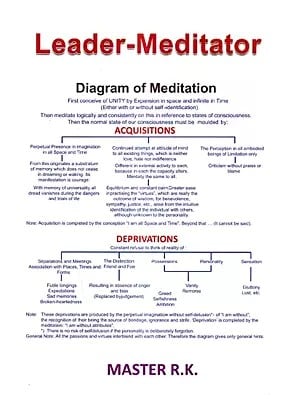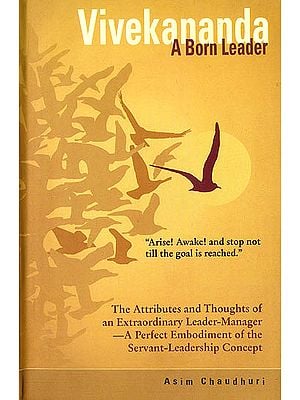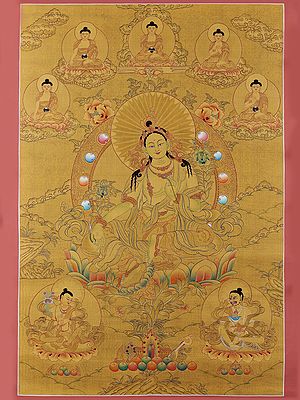Vivekananda A Born Leader (The Attributes And Thoughts of An Extraordinary Leader-Manager)
| Specifications |
| Publisher: ADVAITA ASHRAM KOLKATA | |
| Author: Asim Chaudhuri | |
| Language: English | |
| Pages: 240 | |
| Cover: Hardcover | |
| 8.5 inch X 6.5 inch | |
| Weight 360 gm | |
| Edition: 2011 | |
| ISBN: 9788175053441 | |
| NAD729 |
| Delivery and Return Policies |
| Ships in 1-3 days | |
| Returns and Exchanges accepted within 7 days | |
| Free Delivery |
The profile of Vivekananda as "A Leader" had previously never been studied and thought about on its own, especially in the light of modem management and leadership theories. The author of this book has taken the initiative to view Vivekananda in this light and present him to the readers as a model of "a Leader- Manager" or of "the Servant Leadership Concept." He shows that Vivekananda preached and practised the sublime concept of servant-leadership in his life and within his organization eighty years before it was introduced to the corporate world and was accepted as the most singular and powerful statement of leadership concept in modem times.
The author does not claim that this book is a comprehensive treatise on leadership and management, focusing on every - trait a leader or manager is expected to possess. It 40es not deal with quick solutions to managerial problems, nor does it deal with every modem business strategy or management philosophy. It looks at the qualities which radiated through Vivekananda that go to endorse and validate the view that he was an exemplar of one having superb leadership and managerial qualities.
Asim Chaudhuri had left India for the United States in 1965 for post- graduate studies in Engineering and Management. He spent his entire professional career working at Caterpillar Inc., the world's largest manufacturer of earthmoving equipment based in Peoria, Illinois, as a manager in the Research, Engineering, Manufacturing, and Quality departments. He is a Six Sigma Black Belt. His personal research following Vivekananda's footprints in the United States culminated in two seminal books: Swami Vivekananda in Chicago: New Findings and Swami Vivekananda in America: New Findings (both published by Advaita Ashrama, Kolkata, India, in 2000 and 2008 respectively). He is the recipient of the prestigious Vivekananda Award 2009, given by the Ramakrishna Mission Institute of Culture, Kolkata, India. He now lives in Phoenix: Arizona.
It gives me great pleasure to write this Foreword to the book on Swami Vivekananda by Sri Asim Chaudhuri, for many reasons. The proximate reason had been the request for it by Sri S. P. Mukerjee, a long-term fellow student of management, with a distinguished career in the Indian public and private industrial sectors. His request was followed by a formal invitation from Swami Shuddhidananda of Advaita Ashrama. That invitation is like a command. There is no question that I have to comply. I owe a deep debt of gratitude to the Ramakrishna Math and Ramakrishna Mission organization. During my formative years in Kolkata, from 1961 to 1964, I had the great good fortune to listen to the lectures of Swami Ranganathananda on the Bhagavad Gita and the 11 major Upanishads. Every Saturday, from 6.30 to 8 p.m., the lecture took place in the majestic Vivekananda Hall in the Ramakrishna Mission Institute of Culture, Gol Park. The hall used to be fully packed, with pin-drop silence, and a torrent of ideas, filled with examples and feelings, flowed from the Swami. It made a deep impression on me. I bought the eight volumes of the Complete Works of Swami Vivekananda. They have since been a constant source of reference and inspiration. From my home library they have inspired many others. One of them was my talented, but rebellious, younger cousin, who found deep answers to many questions that had agitated him during his teenage identity crisis and its resolution. He became a disciplined soldier of the Indian army, saw action in the Bangladesh Liberation in 1971, with the IPKFin Sri Lanka, in Kashmir, and in Assam. Soon after his retirement as a Lt. Colonel, he sadly died in his prime in a road accident. By then he had, in his own way, passed on Swamiji's message and passion to many youngsters. This is a micro example that lends credence to Chaudhuri's thesis toward the end of the book that the Complete Works of Swami Vivekananda is a powerful guide and a source of inspiration for people aspiring to leave a mark in the world. Countless others have been inspired and have acted, but their stories have not been publicized. The most important motivation to write this Foreword is my deep appreciation of the invaluable contribution of Sri Asim Chaudhuri through his painstaking research and writing of this book, his third on Swamiji. I greatly value this book from two standpoints: first, as one of millions of disciples and beneficiaries of Swamiji's timeless inspiration, and secondly, as a lifelong student of management, including the important subject of leadership.
Chaudhuris achievement in bringing out this book is commendable in many ways. He has kept up his interest in Swamiji along with a busy managerial career at Caterpillar Inc., an earthmoving and farm equipment MNC, well known worldwide, including, of course, India. Utilising his stay in the U.S. creatively, Chaudhuri has found synergy in working on Swamiji's wanderings, speeches, and teachings in the Chicago area and in other parts of America. He has also brought together his managerial and leadership experiences, with people and processes, on the one hand, and his sustained interest in Swamijis life and work, on the other. It is at such interesting matrices of experience and knowledge from two different streams that creative insights are born. The book is full of such insights.
Chaudhuri is one more example of the intellectual stream of Bengal. The tradition goes back at least to the Bengal Renaissance of the 19th century. Over the last hundred years, the people of Bengal got differentiated into broadly two streams: the spiritual aesthetic stream of Sri Ramakrishna and Rabindranath Tagore, and the Marxist stream. And in the last few decades, it is the latter that has been dominant in Bengal, with the former, as if, gone into a shell for safety. Predominantly materialistic philosophies like Marxism and laissez faire capitalism reach a dead-end sooner or later. Marxism has faded after the spectacular failure of the Soviet economy, formally acknowledged in 1989. Poorly regulated capitalism has brought the global economy under one more severe crisis. One of the fascinating questions of modern Indian history is: if West Bengal had blended the dynamic, dedicated action philosophy of Swami Vivekananda and the new entrepreneurial opportunities of an independent India, how it might have continued to power Indian trade and development? However, today the economy of West Bengal is very much at low ebb. Kolkata port, which handled 40% of India's sea trade in 1947, has declined. The vacuum has been filled by the ports of Maharashtra and Gujarat. Nevertheless, we may yet see an economic regeneration of West Bengal, albeit delayed by half a century, and in that process, Swamiji's underlying commonsense wisdom on Management and Leadership could be of great help to the entrepreneurs, managers, workers, union leaders, bureaucrats and politicians of West Bengal, and of India and world for that matter. Chaudhuri's book is a timely, valuable guide in that process of self-transformation by all the above important actors.
It is a pleasure to anticipate the coming simultaneous release, in Bangladesh and in India, of a film on Tagore, partly shot in Bangladesh, at the places where he lived and composed in his early years. It is scheduled for release next year, 2011, as part of the 150th birth anniversary of our shared poet and Nobel Laureate. How marvellous it would be if there were similar joint celebrations of the 150th birth anniversary of Swamiji in 2013! The Indian Prime Minister is Chairman of the Celebration Committee set up by the Government of India. Is it just an idealist's dream that Sheikh Hasina, Prime Minister of Bangladesh, be invited, and she gracefully accepts to be the Co-Chair? Swamiji was speaking about the independence and total development of undivided India. He appreciated the many strengths of Islam and Muslim culture. He was much more devastatingly critical of his co-religionists, the Hindus. He talked of the desirable combination of Hindu brain and Muslim brawn. This is, of course, not to rule out Muslim brain. In his own intuitive way he was touching upon the management concept of "distinctive competence” and the economics' concept of "comparative advantage:' in such a celebration, whether joint or, alas, only Indian, books like that of Chaudhuri's will be a valuable input. Indeed, the Government of India could consider making the celebration tripartite, by inviting the U.S. Government and or a prominent civil organization in the U.S. to be also a partner, considering Swamiji's thundering oration at the Chicago's World's Parliament of Religions of 1893, and his significant contribution to American culture, heritage, and history.
Chaudhuri has gone into much well-known management theories and concepts and related them to Swamiji's teachings and actions. Swamiji was a born leader. His quest was "Man-making:' In the process he also inspired people and developed leaders. He had done that, both within his organization and outside. He continues to do this, beyond his lifetime, by the power of his heritage. He may be regarded as a Chiranjeevi (Deathless, Eternal) mentor of leaders. He had charisma, but deployed it for the good of humanity and not for personal power and pleasure. He led through service, and exhorted his fellow-monks, juniors, audiences and readers to do likewise. Mahatma Gandhi has been a global beacon of servant-leadership; Swamiji was one of his inspirations.
Swamiji, in my humble opinion, was more of a Karmayogi, while he did, of course, possess Jnana and Bhakti as well His powerful action orientation strongly rubbed off on Nehru, who worked feverishly for Indian independence, and for post-Independence nation-building and economic development. His action bias was intense, inspired partly by Swamiji.
Chaudhuri brings out many of the leadership traits of Swamiji. One of these is "Organizing Power:' I recall addressing a large youth audience in Belur in 1992, at the invitation of the Math, on "The Power of the Mind for Leadership in the 21st Century:' At that time I visited, once more, the small building on the banks of the Hooghly where Swamiji and his brother-disciples founded the Ramakrishna Math and Mission. It is a tribute to Swamiji's organizing power that from that small shed the twin entities have grown into a global organization, with more than 150 centres, from San Francisco to Sydney. We may revere him as a reincarnation of Adi Shankaracharya, who was another unbelievable organizer. At an even younger age than Swamiji, Shankara Bhagavatpada rejuvenated Hinduism and united the country building four Maths in four corners of the country. One of these, for example, is the Sringeri Math in Karnataka. In an unbroken succession, since the 9th century, the 36th Shankaracharya is reigning over the spiritual samrajyam (kingdom), not only covering devotees in the four southern states, but all over India and, indeed, globally. There are close ties between the Ramakrishna Math and Mission and the order of monks founded by Adi Shankaracharya. Totapuri, the Guru of Sri Ramakrishna, belonged to the monastic order founded by Adi Shankaracharya. It will be the prayer, not only of Hindus, or Indians, but of all global citizens interested in world peace, that the Ramakrishna Math and Mission founded by Swamiji should continue its-growth and good work for centuries and millennia to come.
Chaudhuri has cited the leadership and management theories of many management experts such as Bennis, Covey, Drucker, Maslow, McGregor, Greenleaf, Senge, Zaleznik, Prahalad and others. He has painstakingly established correspondence between many of their theories and Swamiji's words and deeds. A sceptic or cynic may feel that some of these connections are a bit stretched. But one needs to take a broader view. Most theories are born out of good practice. The practitioner himself may not be consciously aware that he is practising a particular concept. But when the concept is reflected back to him, it makes eminent sense to him.
Swamiji practised much of what he learned from his Master, and also from reading, reflection, travel, etc. If management science, the way we know it now, were available to him, he would have grasped it faster than anyone and brought it into conscious practice for the larger good. But he applied, with his usual great vigour, some of the core principles of leadership and management anyway, though altogether intuitively.
This is a Foreword, not a review. So I must deny myself the temptation to delve more into the specific, detailed points of Chaudhuri on Swamiji as a born leader. I hope I have said enough to deeply interest the potential reader in the book. It deserves a wide audience, not only among corporate executives but also among all in leadership roles in any kind of organization-big or small, commercial, political, or social. May I also commend to the Advaita Ashrama, the publication arm of the Ramakrishna Math and Mission, to arrange for translations of the book into many languages. The first such translation may be into Hindi, to reach the largest single language audience in India. The second translation may be into Bengali to reach the people of both Bengal and Bangladesh, as well as the large Bengali-speaking global diaspora. Translations into other Indian languages may follow. Among foreign languages, French may be chosen first, the language of Romain Rolland, who wrote with so much reverence about both Sri Ramakrishna and Swamiji. I have great pleasure in commending Chaudhuri's book to all thinking citizens of the world, especially the youth. Swamiji was a Vishwa Guru, a World Teacher, not only in spirituality, but also in leadership and management of mass transformation.
Vivekananda has been called a spiritual leader, a prophet, a social reformer, a nationalist, a philosopher, a yogi, a writer, an orator, an educationist, and so on. But nobody has seriously looked at and analysed his vision, mission, plans, communications, decisions, and actions to see how he had been able to incorporate sound leadership and management principles in every step of his life. There are a few scattered references alluding to it, but nowhere in the literature can one find any detailed and systematic analyses of his life, teachings, and interactions with people that depict him as a manager-or more appropriately-s-A LEADER-MANAGER. Although hundreds of books and articles have been written about Vivekananda, his role as a leader-manager has remained largely unexplored.
People mainly see Vivekananda as a spiritual giant who was instrumental in carrying out his Master Sri Ramakrishna's divine plan of spreading the idea of religious harmony and the gospel of Vedanta. That is not totally fair, because people then tend to overlook many rich but subtle aspects of the multi-faceted nature of his character and personality. When Sri Ramakrishna said, "Naren will teach;' it had very deep implication that went beyond the subject of spirituality into the realm of managing work and life-translating vision into action. Implicit in that statement was the expression, "Naren will lead:' Vivekananda was no doubt a teacher-a World Teacher at that. But he was also a leader, because he had the foresight and wherewithal to improve our quality of thought and quality of life and move us into the exciting unknown as better people. That is what a true leader does.
There exists a universal craving for dynamic and compelling leadership, but it is hard to come by. It may be because people do not properly understand the essence of leadership, or often misinterpret it. Leaders have to have a vision. Then comes integrity, and that is where most "so-called" leaders fail the leadership test. Add implementation skill to that, and it becomes a daunting task to find one. Vivekananda was a rarity having all three-and a host of other qualities to go along with these-held together with the thread of spirituality. He was only two years of age when President Abraham Lincoln was assassinated after a little over four years in office, but these two men were probably the greatest leaders of their respective countries in the last two centuries because they did so much for so many in such a short time.
Although Vivekananda was involved in founding two Vedanta Societies in the United States, he played a minor role in their propagation. He, nevertheless, chose his successors (Swamis Abhedananda, Saradananda, Turiyananda, and Trigunatitananda) carefully to carryon the work he had started in America. His major thrust was directed at the work in India. He started thinking about it soon after he had reached the shores of America in 1893, but it required his physical presence in India to launch it.
On his return after his first trip to the West, Vivekananda started giving shape to his ideas that were interspersed in many of his letters from abroad. He streamlined the Math life (an already existing entity), introduced the rules for guiding it, applied the ideals of neo-monasticism and training of the novices, and on May 1, 1897, founded the Ramakrishna Mission Association, an organized socio-religious movement to help the masses through educational, cultural, medical, and relief work that has grown into a massive institution since its inception. In time, the two arms of the Ramakrishna Movement became jointly known as Ramakrishna Math and Ramakrishna Mission, managed entirely by the monks of the Ramakrishna Order. The Ramakrishna Math arm perpetuates the essential traditions of India’s spiritual culture and heritage, whereas the Ramakrishna Mission provides service to humanity as part of the spiritual discipline of its members. "Although Ramakrishna Math and Ramakrishna Mission are legally and financially separate, they are closely inter-related in several other ways, and are to be regarded as twin organizations;' the establishment declares at its website. For the purpose of this book, no distinction will be made between the two; they will be addressed jointly as the organization Vivekananda founded and led under the banner of "Ramakrishna Movement.’’
Western scholars on the subject of leadership have largely ignored Vivekananda, undoubtedly the most widely known Indian in the late nineteenth-century America and the only Indian rec- ognized and honored by the Smithsonian Institution during the country's Bicentennial Celebration in 1976. Although he was the embodiment of religious harmony, people know him mainly as an Apostle of Hinduism. In the highly parochial world of religion, you hardly get a point for that. At the same time, the secularists have also ignored him for his unapologetic emphasis on Hinduism, or more specifically, the Sanatana Dharma (Eternal Religion). Being ignored by both groups, his unique "leader-manager" persona remains hidden for most people. I hope this book will make them look at him from a different perspective.
Vivekananda might not have been formally schooled in leadership and management theories, but the ideas he practised and preached in the process of founding the organization and running it initially indicate his deep understanding and knowledge of those theories, which will be apparent as one turns the pages of this book.
Contents
| Foreword | 14 |
| A Short Biographical Sketch of Vivekananda | 21 |
| Introduction | 31 |
| Chapter 1: Leadership and Vivekananda | 35 |
| Some Definitions-How Vivekananda Fits in | 35 |
| Leaders-Born or Made? | 40 |
| No-Followers-no Leader | 47 |
| Leadership and Charisma | 50 |
| Servant-leadership | 53 |
| Paradigam Shift | 61 |
| Leadership and Management | 65 |
| Chapter 2: Leadership Traits (and Managerial Skills) of Vivekananda | 68 |
| Having a Vision | 69 |
| A Bias for Action | 73 |
| Capacity for Empathy | 79 |
| Capacity for Empowerment | 81 |
| Organizing Power | 85 |
| Aligning Goals and Objectives | 96 |
| Developing People | 100 |
| Integrity | 105 |
| Self-Confidence | 109 |
| Fairness | 114 |
| Propensity for Hard Work | 116 |
| Ability to Transform Others | 118 |
| Communication Skill | 119 |
| Wisdom | 123 |
| Magnanimity | 126 |
| Being Impersonal | 130 |
| Patience | 134 |
| Building Loyalty | 135 |
| Interpersonal Skills | 138 |
| Unselfishness | 142 |
| Process Focus | 147 |
| Root Cause Emphasis | 151 |
| Constancy of Purpose | 153 |
| Sense of Humor | 156 |
| Forsight | 161 |
| Chapter 3: Managing Paradoxes | 164 |
| Promptitude | 166 |
| Managing Money | 169 |
| Internal Conflict | 173 |
| Commoners and the Elite | 175 |
| Chapter 4: Vivekananda Unbound: Beyond Traits and Skills | 177 |
| Man-Making Education | 178 |
| Influence of Nature's Three Forces | 185 |
| Human Capital | 191 |
| Personal Mastery | 195 |
| Core Competence | 200 |
| Chapter 5: Measuring Leader's Accomplishment | 202 |
| Did the Leader Grow the Enterprise? | 203 |
| Did the Leader's Enterprise Achieve some Level of Prominence? | 207 |
| Did the Leader Leave a Positive Legacy? | 208 |
| Epilogue | 211 |
| Abbreviations and Short Forms Used in the References | 217 |
| References | 218 |
| Index | 238 |






-
Q. What locations do you deliver to ?A. Exotic India delivers orders to all countries having diplomatic relations with India.
-
Q. Do you offer free shipping ?A. Exotic India offers free shipping on all orders of value of $30 USD or more.
-
Q. Can I return the book?A. All returns must be postmarked within seven (7) days of the delivery date. All returned items must be in new and unused condition, with all original tags and labels attached. To know more please view our return policy
-
Q. Do you offer express shipping ?A. Yes, we do have a chargeable express shipping facility available. You can select express shipping while checking out on the website.
-
Q. I accidentally entered wrong delivery address, can I change the address ?A. Delivery addresses can only be changed only incase the order has not been shipped yet. Incase of an address change, you can reach us at help@exoticindia.com
-
Q. How do I track my order ?A. You can track your orders simply entering your order number through here or through your past orders if you are signed in on the website.
-
Q. How can I cancel an order ?A. An order can only be cancelled if it has not been shipped. To cancel an order, kindly reach out to us through help@exoticindia.com.











































